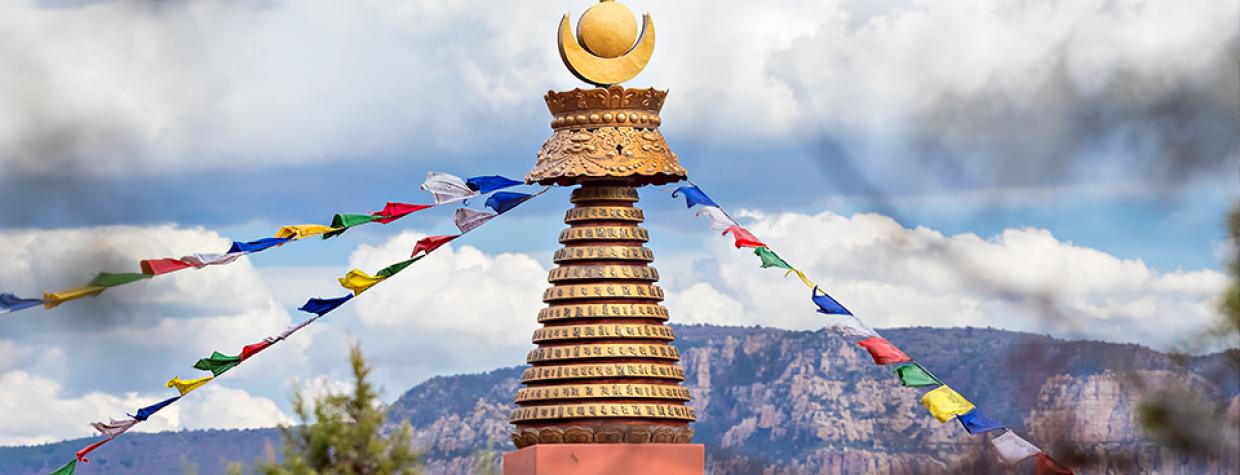Sedona is a city that’s well known for its spirituality-focused destinations. It has what might be called a vibe. From aura readings to vortex visits, Red Rock Country draws those searching for moments of meditation and mindfulness.
That spiritual reputation inspired Buddhist leader Jetsunma Ahkon Lhamo to travel to Sedona in 1997 and visit a special place at the base of Thunder Mountain. Today, visitors to that same place will find Amitabha Stupa and Peace Park.
For many, it’s a surprise to come across the park while hiking the popular trails in the area. The colorful flags blowing in the breeze between juniper trees are the first sign that something is hidden just off the trail. Following the flags leads you to an interesting discovery: the main stupa, or Buddhist shrine. The 36-foot-tall structure (right) stands in the middle of an opening amid the red rocks. Its reddish-pink color blends well with the surroundings, but it still stands out as a place that’s there not by accident, but by design. “Jetsunma was walking this land when she had a vision that this place was appropriate for a stupa,” says Olin Robie, a volunteer caretaker and member of the team that helped build the park. Stupas, an important part of the Buddhist faith, begin as a vision from someone who is considered a “spiritual master.”
When Jetsunma — a native New Yorker who was the first Western woman to be named a reincarnated Buddhist lama — envisioned the Amitabha stupa, she saw a place that would bring peace during turbulent times and blessings for those who visit or live in Sedona.
Her vision came to life in 2004 through the work of volunteers from around the world. They worked for 18 months — not only to build the stupa, but also to consecrate it. The inside of the structure is filled with sacred offerings that have been blessed and gone through Buddhist rituals that date back 2,000 years. “The offerings and prayers are for the growth of compassion in the world and the end of suffering,” Robie says. “They are also for each individual visitor to have growth on their spiritual path.” The stupa is named after the Buddhist deity Amitabha, known as the Buddha of limitless life and enlightenment. But the stupa and park are not only for those who practice Buddhism; people of all faiths are welcome. Visitors can leave written prayers at the stupa, as well as monetary or material donations as offerings. “People will find that their prayer activity or meditation is enhanced on this land,” Robie says. Robie estimates that anywhere between 35,000 and 45,000 people visit the park every year. Many of those visitors are in search of spiritual awakening, while others stumble upon it and learn something new about the Buddhist faith.
“If someone has a belief in prayer or meditation or any kind of visualization, then they would benefit from coming to the stupa,” Robie says. “I think they would gain a profound experience and peace there.” On the north side of the park is a stupa of White Tara (left), the female Buddha. This 6-foot-tall figure is considered to embody the principles of the White Tara, known for mothering and nurturing energy in the Buddhist faith.
The Amitabha Stupa and Peace Park is open daily from dawn to dusk, and local caretakers, such as Robie, conduct informational presentations there for those interested in learning about the stupa’s origins.
Amitabha Stupa and Peace Park, 650 Pueblo Drive, vtara.org/stupas/sedona-arizona

